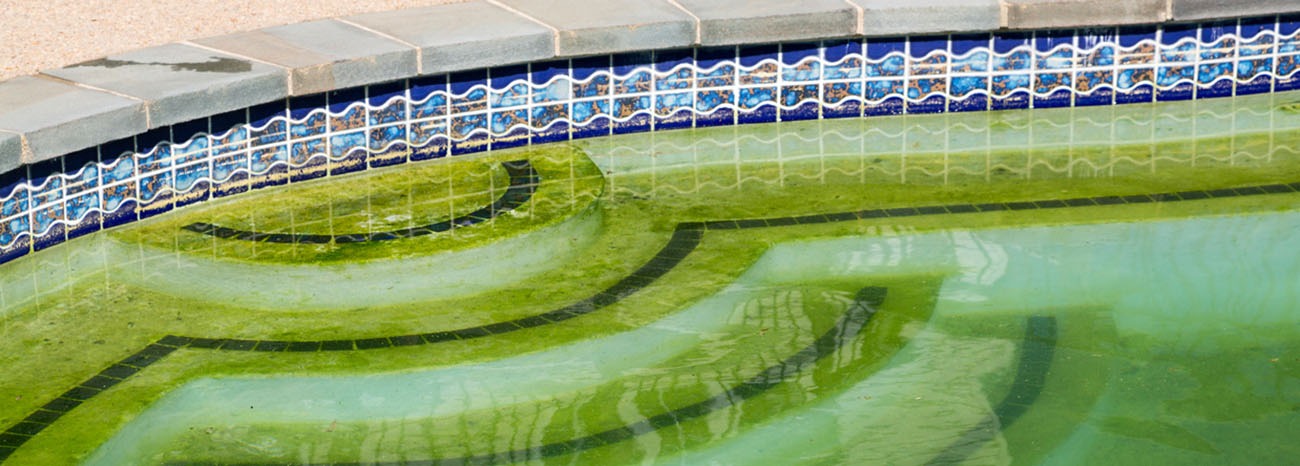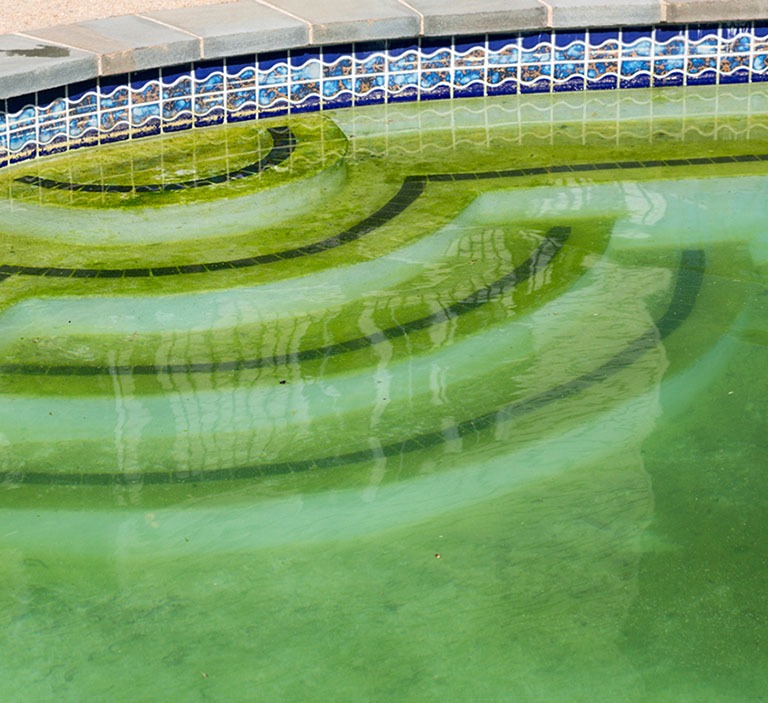Your pool is your oasis. The place you look forward to spending time cooling down during the hot summer months. It’s the space for relaxation and exercise for the entire family. This experience can quickly turn sour if your pool is not maintained properly, especially when it comes to unsightly and unsafe algae.
Algae not only destroys the visual appeal of your pools and spas with its unattractive green, black, pink or yellow hues, it also poses significant health risks by harboring bacteria and creating slippery surfaces that can lead to accidents. The presence of algae indicates an imbalance in your pool’s water chemistry, which can lead to worse problems if not addressed quickly.
Algae-infested waters can reduce the lifespan of your pool’s surface and filtration system and increase maintenance costs. That’s why it’s important to understand the causes of algae growth and implement an effective algae control method.
Why Does Your Pool Have Algae?
Pool algae are microscopic plants that thrive in aquatic environments, including swimming pools and indoor spas. Algae growth in pools and spas is primarily fueled by sunlight, warm temperatures and the presence of nutrients such as nitrates and phosphates. This can be caused by insufficient water circulation and filtration, imbalanced water chemistry or lack of regular maintenance.
There are several types of algae commonly found in pools, each with distinct characteristics:
- Green Algae: The most common type, easily recognizable by its vibrant green color. It can quickly spread throughout the water, turning it cloudy and making surfaces slippery.
- Black Algae: Known for its dark color and root-like structures, black algae firmly attach to pool surfaces, particularly in cracks and crevices, making it challenging to remove.
- Mustard or Yellow Algae: This type appears as yellow or brown patches on pool walls and floors. It is often mistaken for sand or dirt due to its color and can be resistant to standard chlorine treatments.
- Pink Algae: Contrary to its name, pink algae is actually a form of mold and not an algae or bacteria. It thrives in warm, stagnant water and is more prevalent in regions with higher temperatures. Without proper management, it can quickly spread.
It’s important to note that each type of algae requires unique treatment approaches for elimination. A qualified pool professional will know exactly what to do upon inspection.
How to Detect Early Signs of Pool Algae
Catching algae growth at the very beginning is key in maintaining the overall health and appearance of your pool. Algae can quickly transform your clear pool into a slippery, murky, and color-tinted mess. The symptoms of an algae infestation can be subtle at first. The longer you leave it untreated, the harder it will be to get rid of.
Here are some signs and symptoms of algae growth:
- Discoloration: Look for green, yellow, black, pink, or brown stains on the pool walls, floor, or in the water itself.
- Cloudy Water: Algae spores can turn pool water cloudy and hinder visibility, making it difficult to see the bottom of the pool.
- Slippery Surfaces: Algae can create a slimy layer on pool surfaces, leading to slippery steps and floors, posing an additional safety risk.
- Unpleasant Smells: A musty or earthy smell can emerge from pool water infested with algae.
- Increased Chlorine Demand: If your pool requires more chlorine than usual to maintain proper levels, it could be due to the presence of algae consuming the available chlorine.
If you allow your algae problem to go unchecked, your pool – and your summer – will suffer:
- Reduced Water Quality: Algae depletes the water’s oxygen, affecting its visibility.
- Health Risks: Algae can harbor bacteria and pathogens, increasing the risk of skin irritations, infections, and other health issues.
- Damage to Pool Equipment: Algae can clog filters and reduce the efficiency of pool pumps, sanitation systems and heating systems.
- Increased Maintenance Costs: Dealing with severe algae infestations can be costly, requiring additional chemicals, labor, and potential repairs and replacements.
If you suspect your pool has an algae problem, address it as quickly as possible to keep your pool a safe and enjoyable place for everyone.
How to Get Rid of Pool Algae
Getting rid of your pool algae requires a systematic approach:
- Test and Balance Water Chemistry: Ensure your pool’s pH, alkalinity, and sanitizer levels are within the appropriate ranges. Algae thrives in water with imbalanced chemistry, so testing for proper balance is crucial.
- Brush and Vacuum the Pool: Manually remove algae by thoroughly brushing the walls, floor, steps, and other surfaces of your pool. Vacuum the pool to remove the dislodged algae from the water.
- Apply Chlorine Shock Treatment: Perform a shock treatment with a high chlorine concentration to kill algae and bacteria. Ensure the pool is not used during this treatment and follow the manufacturer’s instructions for the correct dosage.
- Add Algaecide: After shocking the pool, add an algaecide specifically designed to kill remaining algae and prevent future growth. Choose a product suitable for the type of algae present in your pool.
- Filter Continuously: Run your pool’s filtration system continuously for 24 to 48 hours to remove dead algae and clear the water.
- Open and Clean Filter Elements: Inspect and thoroughly clean the pool’s filter elements, including cartridges, sand, or diatomaceous earth filters, to ensure they are not clogged with algae or debris. A clean filter is essential for maintaining clear water and effective algae removal.
- Re-test and Balance the Water: After treatment, re-test your pool water and adjust the chemistry as needed to maintain a balanced environment.
- Regular Maintenance: Continue regular pool maintenance, including brushing, vacuuming, and chemical testing, to prevent algae from returning.
By following these steps, you can effectively rid your pool of algae and maintain a clean swimming environment. Remember, consistency in pool care is key to preventing future algae outbreaks.
How to Prevent Algae in your Pool
As the saying goes, “An ounce of prevention is worth a pound of cure.” Here are some simple ways you can prevent a future algae infestation in your pool:
- Regular Pool Home Maintenance: Consistently clean your pool, including brushing the walls and floor, vacuuming debris and emptying skimmer baskets. This removes algae spores and prevents them from taking hold.
- Professional Pool Maintenance Services: Regular visits from a professional pool service can help detect and address algae risks before they become a problem. Professionals can provide expert advice and treatment options tailored to your pool’s specific needs.
- Water Chemistry Management: Regularly test and balance your pool’s water chemistry. Keep the pH, alkalinity and sanitizer levels within the recommended ranges to kill algae growth.
- Use Algaecide Regularly: Incorporate a quality algaecide into your maintenance routine. Apply it according to the manufacturer’s instructions to prevent algae from developing.
- Ensure Proper Circulation and Filtration: Run your pool’s pump and filter system for at least 8-12 hours daily to make sure water is properly circulated and filtered. This also helps distribute chemicals evenly and removes algae spores from the water.
- Shock the Pool Weekly: Regularly shock your pool to kill bacteria and algae spores. (Only do this after heavy pool usage, rainstorms, or significant temperature changes.)
- Keep the Pool Covered: When not in use, cover your pool to reduce sunlight exposure, which algae need for photosynthesis, and to keep out gunk that can contain algae spores.
- Regular Pool Usage: Frequent swimming naturally helps keep the water moving and disrupts algae growth. Use your pool and move that water.
- Remove algae food sources like phosphates and nitrates by testing and balancing your water, making sure your filtration is working efficiently and changing the water in your pool on a regular schedule.
By taking these steps, you can significantly reduce the likelihood of algae growth and maintain a healthy and clear pool all season long.


